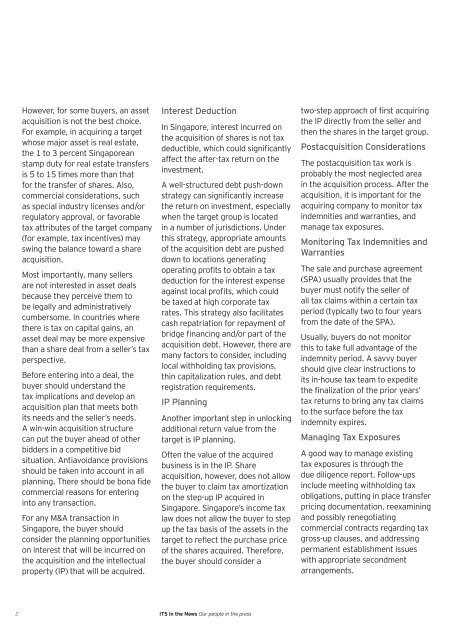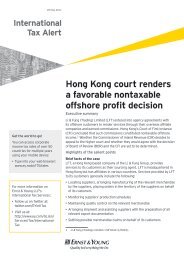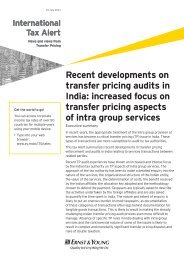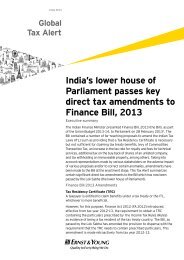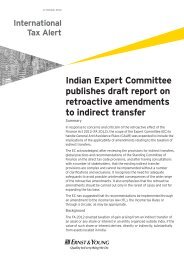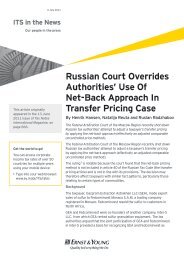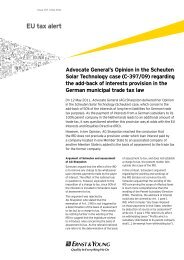M&A Transactions in Singapore - Ernst & Young T Magazine
M&A Transactions in Singapore - Ernst & Young T Magazine
M&A Transactions in Singapore - Ernst & Young T Magazine
You also want an ePaper? Increase the reach of your titles
YUMPU automatically turns print PDFs into web optimized ePapers that Google loves.
However, for some buyers, an asset<br />
acquisition is not the best choice.<br />
For example, <strong>in</strong> acquir<strong>in</strong>g a target<br />
whose major asset is real estate,<br />
the 1 to 3 percent S<strong>in</strong>gaporean<br />
stamp duty for real estate transfers<br />
is 5 to 15 times more than that<br />
for the transfer of shares. Also,<br />
commercial considerations, such<br />
as special <strong>in</strong>dustry licenses and/or<br />
regulatory approval, or favorable<br />
tax attributes of the target company<br />
(for example, tax <strong>in</strong>centives) may<br />
sw<strong>in</strong>g the balance toward a share<br />
acquisition.<br />
Most importantly, many sellers<br />
are not <strong>in</strong>terested <strong>in</strong> asset deals<br />
because they perceive them to<br />
be legally and adm<strong>in</strong>istratively<br />
cumbersome. In countries where<br />
there is tax on capital ga<strong>in</strong>s, an<br />
asset deal may be more expensive<br />
than a share deal from a seller’s tax<br />
perspective.<br />
Before enter<strong>in</strong>g <strong>in</strong>to a deal, the<br />
buyer should understand the<br />
tax implications and develop an<br />
acquisition plan that meets both<br />
its needs and the seller’s needs.<br />
A w<strong>in</strong>-w<strong>in</strong> acquisition structure<br />
can put the buyer ahead of other<br />
bidders <strong>in</strong> a competitive bid<br />
situation. Antiavoidance provisions<br />
should be taken <strong>in</strong>to account <strong>in</strong> all<br />
plann<strong>in</strong>g. There should be bona fide<br />
commercial reasons for enter<strong>in</strong>g<br />
<strong>in</strong>to any transaction.<br />
For any M&A transaction <strong>in</strong><br />
S<strong>in</strong>gapore, the buyer should<br />
consider the plann<strong>in</strong>g opportunities<br />
on <strong>in</strong>terest that will be <strong>in</strong>curred on<br />
the acquisition and the <strong>in</strong>tellectual<br />
property (IP) that will be acquired.<br />
Interest Deduction<br />
In S<strong>in</strong>gapore, <strong>in</strong>terest <strong>in</strong>curred on<br />
the acquisition of shares is not tax<br />
deductible, which could significantly<br />
affect the after-tax return on the<br />
<strong>in</strong>vestment.<br />
A well-structured debt push-down<br />
strategy can significantly <strong>in</strong>crease<br />
the return on <strong>in</strong>vestment, especially<br />
when the target group is located<br />
<strong>in</strong> a number of jurisdictions. Under<br />
this strategy, appropriate amounts<br />
of the acquisition debt are pushed<br />
down to locations generat<strong>in</strong>g<br />
operat<strong>in</strong>g profits to obta<strong>in</strong> a tax<br />
deduction for the <strong>in</strong>terest expense<br />
aga<strong>in</strong>st local profits, which could<br />
be taxed at high corporate tax<br />
rates. This strategy also facilitates<br />
cash repatriation for repayment of<br />
bridge f<strong>in</strong>anc<strong>in</strong>g and/or part of the<br />
acquisition debt. However, there are<br />
many factors to consider, <strong>in</strong>clud<strong>in</strong>g<br />
local withhold<strong>in</strong>g tax provisions,<br />
th<strong>in</strong> capitalization rules, and debt<br />
registration requirements.<br />
IP Plann<strong>in</strong>g<br />
Another important step <strong>in</strong> unlock<strong>in</strong>g<br />
additional return value from the<br />
target is IP plann<strong>in</strong>g.<br />
Often the value of the acquired<br />
bus<strong>in</strong>ess is <strong>in</strong> the IP. Share<br />
acquisition, however, does not allow<br />
the buyer to claim tax amortization<br />
on the step-up IP acquired <strong>in</strong><br />
S<strong>in</strong>gapore. S<strong>in</strong>gapore’s <strong>in</strong>come tax<br />
law does not allow the buyer to step<br />
up the tax basis of the assets <strong>in</strong> the<br />
target to reflect the purchase price<br />
of the shares acquired. Therefore,<br />
the buyer should consider a<br />
2 ITS <strong>in</strong> the News Our people <strong>in</strong> the press<br />
two-step approach of first acquir<strong>in</strong>g<br />
the IP directly from the seller and<br />
then the shares <strong>in</strong> the target group.<br />
Postacquisition Considerations<br />
The postacquisition tax work is<br />
probably the most neglected area<br />
<strong>in</strong> the acquisition process. After the<br />
acquisition, it is important for the<br />
acquir<strong>in</strong>g company to monitor tax<br />
<strong>in</strong>demnities and warranties, and<br />
manage tax exposures.<br />
Monitor<strong>in</strong>g Tax Indemnities and<br />
Warranties<br />
The sale and purchase agreement<br />
(SPA) usually provides that the<br />
buyer must notify the seller of<br />
all tax claims with<strong>in</strong> a certa<strong>in</strong> tax<br />
period (typically two to four years<br />
from the date of the SPA).<br />
Usually, buyers do not monitor<br />
this to take full advantage of the<br />
<strong>in</strong>demnity period. A savvy buyer<br />
should give clear <strong>in</strong>structions to<br />
its <strong>in</strong>-house tax team to expedite<br />
the f<strong>in</strong>alization of the prior years’<br />
tax returns to br<strong>in</strong>g any tax claims<br />
to the surface before the tax<br />
<strong>in</strong>demnity expires.<br />
Manag<strong>in</strong>g Tax Exposures<br />
A good way to manage exist<strong>in</strong>g<br />
tax exposures is through the<br />
due diligence report. Follow-ups<br />
<strong>in</strong>clude meet<strong>in</strong>g withhold<strong>in</strong>g tax<br />
obligations, putt<strong>in</strong>g <strong>in</strong> place transfer<br />
pric<strong>in</strong>g documentation, reexam<strong>in</strong><strong>in</strong>g<br />
and possibly renegotiat<strong>in</strong>g<br />
commercial contracts regard<strong>in</strong>g tax<br />
gross-up clauses, and address<strong>in</strong>g<br />
permanent establishment issues<br />
with appropriate secondment<br />
arrangements.


